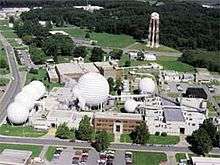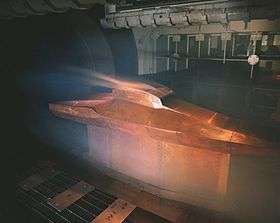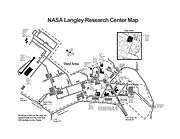Langley Research Center
 | |
 Aerial view of Langley Research Center | |
| Agency overview | |
|---|---|
| Formed | 1917 |
| Preceding agency |
|
| Jurisdiction | U.S. federal government |
| Headquarters | Hampton, Virginia, U.S. |
| Agency executive |
|
| Parent agency | NASA |
| Website |
www |
| Map | |
|
Map of NASA Langley Research Center | |
Langley Research Center (LaRC) is the oldest of NASA's field centers, located in Hampton, Virginia, United States. It directly borders Langley Field and the city of Poquoson. LaRC focuses primarily on aeronautical research, though the Apollo lunar lander was flight-tested at the facility and a number of high-profile space missions have been planned and designed on-site.
Established in 1917 by the National Advisory Committee for Aeronautics, the Center currently devotes two-thirds of its programs to aeronautics, and the rest to space. LaRC researchers use more than 40 wind tunnels to study improved aircraft and spacecraft safety, performance, and efficiency. Between 1958 and 1963, when NASA started Project Mercury, LaRC served as the main office of the Space Task Group, with the office being transferred to the Manned Spacecraft Center (now the Lyndon B. Johnson Space Center) in Houston in 1962–63.
The current director is David E. Bowles.
History
In 1917, less than three years after it was created, the NACA established Langley Memorial Aeronautical Laboratory on Langley Field. Both Langley Field and the Langley Laboratory are named for aviation pioneer Samuel Pierpont Langley.[1] The Aviation Section, U.S. Signal Corps had established a base there earlier that same year. The first research facilities were in place and aeronautical research was started by 1920. Initially the laboratory included four researchers and 11 technicians.[2]

Langley Field and NACA began parallel growth as air power proved its utility during World War I. The center was originally established to explore the field of aerodynamic research involving airframe and propulsion engine design and performance. In 1934 the world's largest wind tunnel was constructed at Langley Field with a 30 × 60 foot test section; it was large enough to test full-scale aircraft.[3][4] It remained the world's largest wind tunnel until the 1940s, when a 40 × 80 foot tunnel was built at NASA Ames in California.[5])
Early in 1945, the center expanded to include rocket research, leading to the establishment of a flight station at Wallops Island, Virginia. A further expansion of the research program permitted Langley Research Center to orbit payloads, starting with NASA's Explorer 9 balloon satellite in mid-February 1961. As rocket research grew, aeronautics research continued to expand and played an important part when subsonic flight was advanced and supersonic and hypersonic flight were introduced.
Langley Research Center can claim many historic firsts, some of which have proven to be revolutionary scientific breakthroughs. These accomplishments include the development of the concept of research aircraft leading to supersonic flight, the world's first transonic wind tunnels, the Lunar Landing Facility providing the simulation of lunar gravity, and the Viking program for Mars exploration.[6] The center also developed the grooving of aircraft runways, which permits better grip by aircraft tires to the surface than a traditional smooth surface. This grooving is now the international standard for all runways around the world.
Aeronautics

Langley Research Center performs critical research on aeronautics, including wake vortex behavior, fixed-wing aircraft, rotary wing aircraft, air safety, human factors and aerospace engineering. LaRC supported the design and testing of the hypersonic X-43, which achieved a world speed record of Mach 9.6 (almost 7,000 miles per hour). LaRC assisted the NTSB in the investigation of the crash of American Airlines Flight 587.[7][8][9]
Work began in July 2011 to remove the 1940s era 16 feet (4.9 m) transonic wind tunnel. The facility supported development and propulsion integration research for many military aircraft including all fighters since 1960 (F-14, F-15, F-16, F-18 and the Joint Strike Fighter) but had been inactive since 2004.[10] Langley retained transonic wind tunnel testing capabilities facilities in the National Transonic Facility, a high pressure, cryogenically cooled 8.2 feet (2.5 m) closed loop wind tunnel.[11]
Fabrication research and development

Electron beam freeform fabrication (EBF³)
The EBF³ process produces structural metallic parts with immense strength, and useful in performing repairs in remote locations. Additionally, the ability to build functionally graded, unitized parts directly from CAD data offers enhanced performance in numerous applications. Recently, LaRC has become home to this new type of machining process, which is used by their new room-sized electron-emitting device, which uses a High Frequency 42 kW, X-ray emitting electron gun (similar to Cathode Ray Tubes), which quickly melts either aluminum or titanium wire (positioned by dual independent wire feeders) into the desired 3-dimensional metallic parts with a material strength comparable to that of wrought products. The machine's deposition rate is 150 in³/h (690 mm³/s), equivalent to its plastic-fabricating counterpart. Metallic parts are also built directly from CAD without molds or tools, leaving the end product with absolutely no porosity. Other properties include:
- 6-axis positioning
- Heated or cooled platen
- 1×10−6 torr vacuum capability (needed for the high power Electron beam gun)
- 72 × 24 × 24 inch build envelope
- Power efficiency in excess of 90%
- Near 100% feedstock efficiency
- Can deposit reflective materials not processable with lasers
- Potential portable EBF³ system (Under Development)
- Potential Fabrication & repair from the plants to the planets
- Research assistance for developing large scale fabrication in space
Overall, Electron Beam Freeform Fabrication is a layer-additive technique that offers potential for improvements in cost, weight, and performance to enhance mission success for aircraft, launch vehicles, and spacecraft.
Plastic fabrication
LaRC also houses a large collection of various, inexpensive plastic reformation machines. These machines are generally very critical in the freeform fabrication department for faster timing, better precision, and larger quantities of low-cost toy, model, and industrial plastic parts. The fabrication of plastic parts is not all that dissimilar to the EBF³ process, except the melting apparatus is a thin, grated heating element, but other than that they are quite similar, e.g. they are both run completely by CAD data and deal with various freeform fabrication of raw materials. Plastic reformation machines have also come to the interest of graphical artist, opening a whole new world of bringing their masterpieces to life, all with a 'flick' of a switch, so to speak.
Astronautics
Moon

Since the start of Project Gemini, Langley was a center for training of rendezvous in space. In 1965, Langley opened the Lunar Landing Research Facility for simulations of moon landings with a mock Apollo Lunar Module suspended from a gantry over a simulated lunar landscape. There was experimental work on some Lunar Landing Research Vehicles (LLRV).
Mars
Langley Research Center supported NASA's mission by designing a spacecraft for a Mars landing. (see the Mars Exploration Rover.)
Earth science
Langley Research Center conducts earth science research to support NASA's mission.
Awards
LRC scientists and engineers have won the Collier Trophy 5 times. In 1929 for the development of low-drag cowling for radial air-cooled aircraft engines, 1946 to Lewis A. Rodert, Lawrence D. Bell and Chuck Yeager for the development of an efficient wing deicing system, 1947 to John Stack of the then Langley Memorial Aeronautical Laboratory for research to determine the physical laws affecting supersonic flight, also shared in this trophy for their work on supersonic flight, 1951 to John Stack for the development and use of the slotted-throat wind tunnel, 1954 Richard T. Whitcomb for the development of the Whitcomb area rule, according to the citation, a "powerful, simple, and useful method of reducing greatly the sharp increase in wing drag heretofore associated with transonic flight, and which constituted a major factor requiring great reserves of power to attain supersonic speeds."[12]
See also
- Aerospace engineering
- NASA DEVELOP at Langley Research Center
- TsAGI. Russia's equivalent test center and institute (founded in 1918)
References
- ↑ Tennant, Diane (September 5, 2011). "What's in a name? NASA Langley Research Center". The Virginian-Pilot. Retrieved September 5, 2011.
- ↑ "Journey in Aeronautical Research: a Career at NASA-Langley Research Center, ch. 3". NASA.
- ↑ "Faster, Safer Planes, Developed In Biggest Wind Tunnels" Popular Science, April 1934
- ↑ "Full-Size Planes Tested In Big Air Tunnel" Popular Mechanics, April 1935, pp. 520–521
- ↑ "40 X 80 and 80 X 120 Foot Wind Tunnels". Rotorcraft.arc.nasa.gov. Retrieved 2016-02-14.
- ↑ "NASA Langley History and Description: Initial Activities". NASA LaRC Master Plan.
- ↑ "NASA - Hypersonic X-43A Takes Flight". Nasa.gov. Retrieved 2016-02-14.
- ↑ "NASA Cultural Resources (CRGIS) - NasaCRgis". Gis.larc.nasa.gov. 2015-08-04. Retrieved 2016-02-14.
- ↑ "NASA - Hypersonic X-43A Takes Flight". Nasa.gov. Retrieved 2016-02-14.
- ↑ "Tearing down NASA Langley's 16-foot transonic wind tunnel". Daily Press. 2011-07-08. Retrieved 2016-02-14.
- ↑ "National Transonic Facility". Archived from the original on October 17, 2011. Retrieved November 14, 2011.
- ↑ "Exploring NASA's Roots - The History of the Langley Research Center | NASA". Nasa.gov. 1992-12-31. Retrieved 2016-02-14.
External links
| Wikimedia Commons has media related to Langley Research Center. |
- Langley Research Center website
- Langley Research Center Photographs and Movies
- Langley Research Center images at Library of Congress Built In America website
- James R. Hansen: Spaceflight Revolution: NASA Langley Research Center from Sputnik to Apollo (NASA SP-4308, 1995) PDF version
- Crafting Flight: Aircraft Pioneers and the Contributions of the Men and Women of NASA Langley Research Center (NASA SP-2003-4316)
- Engineer in Charge: A History of the Langley Aeronautical Laboratory,1917-1958 (NASA SP-4305, 1987)
- Langley Research Center EBF³ Process Information Site
- (PDF) Concept to Reality: Contributions of the NASA Langley Research Center to U.S. Civil Aircraft of the 1990s (NASA SP-2003-4529)
- (PDF) Partners in Freedom: Contributions of the Langley Research Center to U.S. Military Aircraft of the 1990s (NASA SP-2000-4519)
- Journey in Aeronautical Research: a Career at NASA-Langley Research Center, Monographs in Aerospace History # 12
- Journey Into Space Research: Continuation of a Career at NASA Langley Research Center (sequel to above, PDF link)
- video presentations from NASA LaRC engineers during 2011 NASA Tweetup
Coordinates: 37°05′34″N 76°22′53″W / 37.09277°N 76.38133°W
